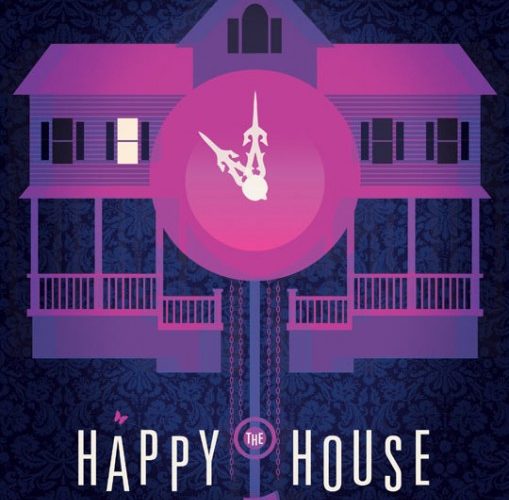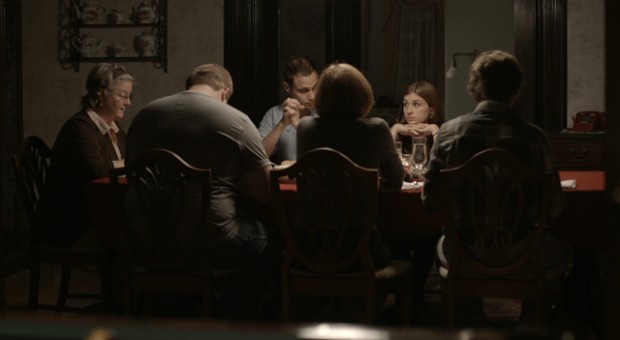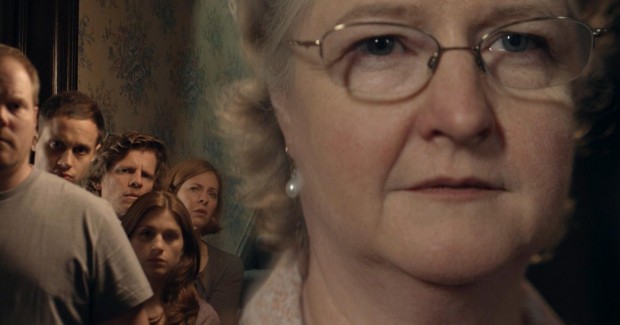There’s something about bed and breakfasts that make me uneasy. If I’m to be honest, it’s the falseness that accompanies mannered politeness treated like commercial transaction. Underneath the warm ‘just like family’ smiles, cozy sitting rooms and piping hot baked goods, there’s always the sense of strings attached, a system of rules and implied codes that keeps everything running sunny. What happens if you don’t remember to hang up the robes, or end up taking more than your allotted share of afternoon cookies?
Of course no harm has ever come to me for leaving the coffee cups coaster-less, but the specter of imaginary retribution remains. Turns out, director D.W. Young has similar thoughts, and he explores them to darkly comic effect in his micro-budget thriller The Happy House. Largely captured in static wide shots that lend everything a sitcom veneer, Young’s film assembles an oddball cast of stereotypes; half escaped out of a Norman Rockwell painting, the rest ported in from The Twilight Zone. There’s the married yuppies trying to rekindle love amidst blueberry muffins and cuckoo clocks, the matronly, Puritanical proprietor with her ‘three strikes’ mantra, a Swedish lepidopterist given to bouts of existential fretting, the sketchy tow-truck driver and that lumpy goon with the axe that looks like Joss Whedon after a Twinkie binge.
If that assembly seems a bit unwieldy, never fear, there’s also a serial killer out there somewhere with plans to dwindle the population to a more manageable number. Before said psycho’s unveiling, Young’s film is content to meander through its early passages with all the urgency of a primetime comedy. The only thing obviously missing is a laugh-track, covered here by Marceline Hugot’s mirthful yet sinister chortling. The filmmaking and acting are largely unimpressive on the surface, and the amateur quality of the production threatens to derail the first fifteen minutes or so, which operate like their own short film. Khan Baykal and Aya Cash as the couple are just too matter-of-fact and complacent—even their bickering lacks a furtive spark—while Hugot’s curious owner and Henzler’s butterfly fanatic are much more interesting and effective as characters.
And yet, The Happy House builds its own unique headspace during that opening stretch that utilizes the shortcomings to sell us a demented vision that connects sanitized television universes with the eerie white-washed generosity of the bed and breakfast culture. While the squabbling Baykal and Cash fear they might be murdered for violating the strict rules of the house—no cursing, no loud music, no late snacking—Hugot and the others move in and out of the frame vacillating between sinister and relieving. Through all of this, House starts to achieve a clever, sneaky rhythm. If the first half ultimately succeeds as a kind of mild-mannered purgatory, equal parts Full House and The Exterminating Angel, it is the second half descent into an honestly involving slasher film that solidifies Young’s quirky little experiment.
The Happy House never becomes an edgy or terrifying experience, and that may be its most endearing quality; its calm little tone, even in the face of characters being killed off, resembles a live-action Scooby Doo episode. That approach ultimately makes the movie more eerie and memorable than it would have been as a straightforward horror pic. One of my complaints with the Ten Little Indians model of horror storytelling is that it requires characters to begin as believable people and then transform into walking meat sacks ripe for gouging. House goes the opposite direction, establishing a roll-call that would be at home in a game of Clue, and then slowly unfurls them as multi-faceted individuals when the stakes are raised. The acting improves and becomes more organic, and the jokes which felt stiff initially gain a little more traction when they are required to lighten the mood.
Even Young’s filmmaking adjusts, and his subtle correlations to James Whale’s classic screwball creep comedy The Old Dark House become more apparent, successful because he swaps Whale’s expected creaking mansions and rain-soaked skies for a brightly lit slice of cheer. The film’s camera translates the house’s geography to us in a surprisingly descriptive manner, sometimes panning to the right or left like a cartoon to reveal characters sitting in rooms we thought they left.
The Happy House has its share of flaws and it’s not quite accomplished enough to be truly effective as a thriller, but at the same time it’s a reasonably entertaining riff on the genre. In a time when horror films don’t often give us characters we enjoy getting to know, Young’s first-time feature deserves a bit of credit for achieving just that.
The Happy House opens in limited release on May 3rd.



